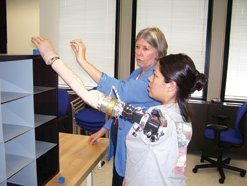A New Touch
Rewired nerves may eventually lead to artificial limbs with a sense of touch.
Share this:
- Share via email (Opens in new window) Email
- Click to share on Facebook (Opens in new window) Facebook
- Click to share on X (Opens in new window) X
- Click to share on Pinterest (Opens in new window) Pinterest
- Click to share on Reddit (Opens in new window) Reddit
- Share to Google Classroom (Opens in new window) Google Classroom
- Click to print (Opens in new window) Print
By Emily Sohn
Many people who have artificial arms or legs find these devices clumsy and difficult to operate. What’s missing is the ability to think about making a movement, then having that movement happen.
Now, researchers from the Rehabilitation Institute of Chicago and their coworkers have moved a step closer toward this goal. They have developed a technique that could eventually allow people to feel heat and other sensations through their new limbs.
 |
|
Claudia Mitchell gets training to use her nerve-activated artificial arm. She is part of new research that may lead to artificial limbs that provide a sense of touch. |
| Rehabilitation Institute of Chicago |
In your body, the nervous system carries messages from your brain to your muscles, telling them what to do. When you want to open your fist, for example, the nerve cells in your hand receive electrical signals that make the finger muscles move.
After the amputation of a hand, however, people also lose the hand’s nerve cells—and the ability to move the limb just by thinking about it or to feel anything.
To restore nerve-activated movement, the scientists started by identifying the nerves that once led to the lost limb. They then redirected these nerves to muscles in the patient’s chest.
As a result, when the patient thought about moving her arm, the message from her brain ended up in her chest muscles instead of in her hand. The muscles twitched, and a device on the skin picked up the muscles’ signal and sent an electrical pulse to the artificial arm, which then moved.
In a recent study, the first woman to have the procedure reported that moving her artificial arm felt natural.
Scientists also went a step farther. Surgeons rewired sensory nerves that originally went to the hand to a patch of skin that covers the chest muscles. When they later pressed on various parts of this area, the patient felt tingling sensations in what seemed to be individual fingers and the palm of her missing hand.
The patient was also able to feel cold, heat, and vibrations in the lost limb when the scientists applied those sensations to the skin on her chest.
“The fact that they were able to provide this degree of use [with the artificial arm] and the potential for sensory control is really quite wonderful,” comments Gregory A. Clark, a bioengineer at the University of Utah in Salt Lake City.
Next, the group plans to work on developing artificial limbs that will allow their users to feel things. One possibility would be to put sensors on the artificial fingers that would deliver sensations to another part of the body.
Then, it wouldn’t matter if the hand holding a cup of hot cocoa were real or artificial. The cup would still feel hot.—E. Sohn
Going Deeper:
Cunningham, Aimee. 2007. Transferred touch: Sensory rewiring to improve prosthetics. Science News 171(Feb. 10):85. Available at http://www.sciencenews.org/articles/20070210/fob5.asp .
LabZone
How Touchy Are You?
http://www.sciencenewsforkids.org/articles/20031029/LZActivity.asp






